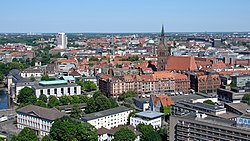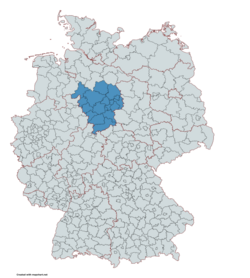Top Qs
Timeline
Chat
Perspective
Hanover–Braunschweig–Göttingen–Wolfsburg Metropolitan Region
Metropolitan region in Lower Saxony, Germany From Wikipedia, the free encyclopedia
Remove ads
The Hanover–Braunschweig–Göttingen–Wolfsburg Metropolitan Region (German: Metropolregion Hannover-Braunschweig-Göttingen-Wolfsburg) is an economic and cultural region in the Lower Saxony state of Northern Germany. The metropolitan region comprises approximately one third of the area of Lower Saxony, with almost half the inhabitants of the state. It has about 3.9 million people in 20 districts and counties with a total of 431 municipalities and is defined by the German Ministerkonferenz für Raumordnung (MKRO) as a medium urban area in Germany.
Remove ads
History
The application for recognition as a European metropolitan region with the German Ministerkonferenz für Raumordnung responsible for regional planning (MKRO) was made early. The recognition should help the region internationally and improve coordination and development of cities. Although the importance of the region and the developments relating to the citynetwork Expo 2000 she was still the smallest of the metropolitan regions. In 2005 a loose co-operation was initiated with the nearby city regions of Braunschweig and Salzgitter and up in the area of Göttingen.
Remove ads
Area description
Summarize
Perspective
Between the cities of the region there are large predominantly agricultural areas. The urban infrastructure network consist of the highways A2, A7 and A39 and fast rail links, in particular some high speed rail (like the Hanover–Würzburg high-speed railway).
The region is mainly based on the service sector and manufacturing. The largest group is the Volkswagen AG headquarters in Wolfsburg. The science and research landscape of the region includes seven universities (including the University of Göttingen, Leibniz University Hannover and the Braunschweig University of Technology), nine colleges, an art college, a music and theater school, and approximately 60 other research institutions (including a large number of Max Planck Society Institutes, two locations of the German Aerospace Center (DLR) in Braunschweig and Göttingen, the Herzog August Bibliothek in Wolfenbüttel and various federal agencies such as BBA, BGR, FAL, PTB).
Radioactive waste is frequently transported in the area to the city of Salzgitter, for the deep geological repository Schacht Konrad and between Schacht Asse II in the Wolfenbüttel district and Lindwedel and Höfer.
Urban agglomerations
The most populated urban agglomerations within the metropolitan region are Hanover, Braunschweig, Hildesheim, Göttingen and Wolfsburg. Hanover is the largest one from all in terms of population.
Hanover is the capital of the state and consists of multiple towns such as Langenhagen, Stadthagen or Garbsen that make up the urban agglomeration. Hanover is the most populated city and agglomeration in the Metropolitan area. Hanover is a metropolis but due its higher dependency for its surroundings leads to a lower amount of centralization, having only slightly higher amount of resources and businesses compared to other cities in the Metropolitan area.
Braunschweig is the densest and most diverse urban agglomeration in the whole state with about 45% of the urban agglomeration having a foreign background. Braunschweig is the largest regiopolis in the area and is after Hanover the second metropolitan city in the region with a population of 272,417. The agglomeration is the second largest in the metropolitan area. Togethor with Hanover, Braunschweig is one of the two major centers in the region.
Hildesheim is the largest urban agglomeration in terms of land space and is situated below the Hanover region. It consists of Salzgitter Bad, Baddeckenstedt, as well as the city Hildesheim.
Salzgitter is part of the urban agglomerations Braunschweig and Hildesheim. 73.1% of the residents in Salzgitter live within the Braunschweig urban agglomeration but most of the land is in Hildesheim's agglomeration. Due to Salzgitter being spread out, it is not an urban agglomeration itself but rather a connection between two agglomerations and part of both. Factories and industries were placed mostly on the emptier side of the city in order to avoid any risks towards urban settlements.
Göttingen is the most isolated urban agglomeration from all and the most sparsely populated urban area in the metropolitan region. Majority of the people in this agglomeration are students and tend to live in the area because of its close proximity to Kassel, a city known for slightly higher living costs than Göttingen.
Wolfsburg, headquarters of Volkswagen, is situated close to Braunschweig and the town Gifhorn, which is also part of Wolfsburg's urban agglomeration. The population of Wolfsburg's urban agglomeration is concentrated within the city area but has some parts in the nearby districts Gifhorn and Helmstedt.
The metropolitan region is divided into four main sectors: Braunschweig, Hildesheim, Hanover and Göttingen. Most of the population is within the Hanover region (1.20 million) and Braunschweig region (1.66 million).[12][13]





Remove ads
Members

Members of the Metropolitan Region Hanover–Brunswick–Göttingen–Wolfsburg are:
- Celle (district)
- Gifhorn (district)
- Göttingen (district)
- Goslar (district)
- Hamelin-Pyrmont (district)
- Hildesheim (district)
- Holzminden (district)
- Nienburg (district)
- Northeim (district)
- Osterode (district)
- Peine (district)
- Schaumburg (district)
- Soltau-Fallingbostel (district)
- City Alfeld
- City Bad Pyrmont
- City Braunschweig
- City Celle
- City Einbeck
- City Garbsen
- City Göttingen
- City Hann. Münden
- Landeshauptstadt Hanover
- City Hildesheim
- City Holzminden
- City Laatzen
- City Langenhagen
- City Lehrte
- Municipality Lengede
- City Nienburg/Weser
- City Northeim
- Oberharz (Samtgemeinde)
- City Osterode am Harz
- City Pattensen
- City Peine
- City Salzgitter
- City Sarstedt
- City Seesen
- City Stadthagen
- City Walsrode
- City Wolfenbüttel
- City Wolfsburg
- Hanover (district)
- Zweckverband Großraum Braunschweig
- Expo-Region, Hameln
See also
References
External links
Wikiwand - on
Seamless Wikipedia browsing. On steroids.
Remove ads


